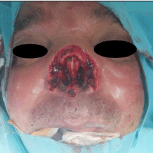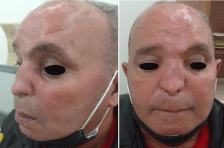
Case Report
Austin J Clin Case Rep. 2021; 8(6): 1214.
Angiosarcoma of the Nose: A Case Report and Review of the Literature
Naija S*, Jameleddine E, Maamouri S, Brahem H, Akkeri Kh and Chebbi G
Department of ENT and Maxillofacial Surgery, Military Hospital of Tunis, Tunis El Manar University, Tunisia
*Corresponding author: Naija S, Department of ENT and Maxillofacial Surgery, Military Hospital of Tunis, Tunis El Manar University, App 42 front mer Bizerte 7000, Tunisia
Received: May 05, 2021; Accepted: May 26, 2021; Published: June 02, 2021
Abstract
Angiosarcoma is a rare and aggressive type of neoplasm that develops in the inner lining of blood vessels and lymph nodes. It accounts for less than 0.1% of head and neck malignancies. The treatment is based on surgery followed by wide field radiotherapy. Anyhow, the risk of local failure and recurrence as well as distant relapse remains high for this disease.
We present in this paper a 55-year-old male patient case, with no significant medical history, who was referred for the evaluation of an erythematous and indurated plaque of 2.5 cm in the bridge of the nose. The physical exam showed no head or neck lymphadenopathy, and no nasal or oral mucosal involvement were noted. Multiple biopsies of the nose were taken, and the diagnosis of the specimens was angiosarcoma. MRI showed only soft tissues involvement and no distant metastasis were found on the CT scans. The patient was subsequently treated with total rhinectomy followed by total nose reconstruction.
Thus, angiosarcoma of the nose is an uncommon pathology and it should be rapidly diagnosed. A delay in the diagnosis could result in significant therapeutic challenges. Surgery and postoperative radiotherapy are the two pillars of treatment.
Keywords: Angiosarcoma; Endothelial cells; Face; Reconstruction
Introduction
Angiosarcomas are rare malignant mesenchymatous tumors that originate in the endothelium of blood vessels and represent approximately 1% to 2% of all head and neck soft tissue sarcomas [1].
They are divided in 3 clinical groups: the first group is angiosarcoma of the elderly, the second is angiosarcoma secondary to chronic lymphedema, occurring primarily after axillaries lymph node dissection for breast cancer, and the third is a complication of radiodermatitis [2].
Its poor prognosis is due mostly to its rapid growth and a high rate of lymphoid and systemic metastasis [1]. No standard treatment has been described but surgery followed by wide-field radiotherapy seems to be the optimal choice while chemotherapy has a palliative role. Even though, there is a relatively high likelihood of a local recurrence at the margins of the radiotherapy fields and the probability of distant metastasis remains high [3].
Case Presentation
A 55-year-old male patient with no significant medical history, including no prior radiotherapy, chronic venous ulceration, lymphedema, was referred to our department for evaluation of an erythematous and indurated plaque in the bridge of the nose and alae.
The lesion had been growing for a three-month period. The physical exam showed a 2.5 cm painless erythematous plaque centered by two violaceous keratotic nodules. No head or neck lymphadenopathy, no nasal or oral mucosal involvement were found (Figure 1).

Figure 1: Erythematous and indurated plaque in the bridge of the nose and
alae.
Multiple biopsies of the nose were taken, and the pathology report revealed a well differentiated angiosarcoma composed of well-formed, irregular vascular channels, lined by flattened endothelial cells. MRI showed only soft tissue involvement and no distant metastasis were found on the CT scans.
The patient was subsequently treated with total rhinectomy (Figure 2) followed by total nose reconstruction using a paramedian forehead flap (Figure 3). He was then addressed to fellow oncologists for postoperative radiotherapy. At the six-month follow-up, we noted the appearance of similar lesions in the peri labial and periorbital regions (Figure 4). Multiple biopsies were taken, and the histopathological exam showed a well differentiated angiosarcoma. The MRI confirmed the recurrence of the lesion with an infiltration of the periorbital fat. A treatment by radiotherapy combined to chemotherapy was decided by the multidisciplinary committee.

Figure 2: Pre-operative photo of rhinectomy.

Figure 3: Reconstruction with forehead flap.

Figure 4: Six months after surgery showing appearance of similar lesions in
the peri labial and periorbital regions.
Discussion
The diagnosis of angiosarcoma is challenging due to the rareness of this tumor, the absence of consistent therapeutic guidelines and its poor prognosis [1]. Therefore, a thorough medical history, a concise physical examination and clinical knowledge are necessary.
Cutaneous angiosarcoma is typically a malignancy of elderly males [1,4], the nose is a rare location and can be easily mistaken for a benign lesion due to its variable presentations [5]. Different clinical pictures have been described in the literature with multiple reports of angiosarcoma mimicking rhinophyma, rosacea, hemangiomas, contact dermatitis and even sebaceous cyst [6]. The lesions can be flat or raised nodular, macules and papules of different sizes. All this can lead to a misdiagnosis [5].
Angiosarcomas are known to grow quickly in a centrifugal pattern and subcutaneous extension [7] and this confusion can also delay the diagnosis and treatment, probably explaining in part its poor prognosis.
In a review article by Mendenhall [3] and al. results showed that 5-year local-regional control rates are approximately 40 to 50%, the 5-year distant metastasis-free survival rates range from 20 to 40%, and the 5-year survival rates range from 10 to 30%.
Even though identification of prognostic factors for recurrence and metastasis is limited by data collection, Gründahl1 and al. attempted to create a predictive score for locoregional metastasis based on the analysis of tumor characteristics and outcome of 103 patients. In this review, 3-, 5-, 10-, and 20-year survival rates were 61%, 49%, 37%, and 26%. Three parameters were found to be significant in the prediction of locoregional metastasis: origin and extent of the primary tumor and the AJCC stage and the patients were then divided in the risk groups (high/medium and low risk).
Those score risks were an attempt to stage patients and thus guide and determine the therapeutic options according to each stage as no common and consistent guidelines are available to this date.
Nevertheless, surgical excision of the tumor remains, when its possible, the first line of therapy. There are no strict guidelines concerning the width of surgical margins but clear margins in the anatomopathological examination ensure lower frequency of recurrence [8].
Nose reconstruction remains challenging as its goal is both aesthetic and functional. The three-dimensional structure of the nose needs to be reconstructed depending on the location, the depth, size and shape of the nasal defect. The forehead flap remains the gold standard of nasal soft tissue reconstruction providing excellent results [9]. Nasal reconstruction can make post-operative checkups in search of a local recurrence more difficult and the proper time of reconstruction following the excision of a malignant tumor is still a matter of debate [10]. A nasal Epithesis can be a good temporary alternative in this case.
Conclusion
Cutaneous angiosarcoma is a rare misleading malignancy of the elderly that should be always kept in mind due to its poor prognosis. The therapeutic strategy must be guided by risk scores to minimize the risk of local regional metastasis.
References
- Gründahl JEH, Hallermann C, Schulze HJ, Klein M, Wermker K. Cutaneous Angiosarcoma of Head and Neck: A New Predictive Score for Locoregional Metastasis. Transl Oncol. 2015; 8: 169-175.
- Hanke CW, Sterling JB. Prolonged survival of angiosarcoma on the nose: A report of 3 cases. Journal of the American Academy of Dermatology. 2006; 54: 883–885.
- Mendenhall WM, Mendenhall CM, Werning JW, Reith JD, Mendenhall NP. Cutaneous Angiosarcoma. American Journal of Clinical Oncology. 2006; 29: 524–528.
- Mark RJ, Poen JC, Tran LM, et al. Angiosarcoma: a report of sixty-seven patients and a review of the literature. Cancer. 1996; 77: 2400–2406.
- Gravvanis A, Lagogiannis G, Kyriakopoulos A, Keramidas T, Kakiopoulos G, Tsoutsos D. Angiosarcoma of the Nasal Septum Mimicking Reticulohistiocytoma. Journal of Craniofacial Surgery. 2013.
- Mecinska-Jundzill K, Bialecka A, Adamska U, Jundzill A, NeskaDlugosz I, Grzanka D, et al. Large primary cutaneous angiosarcoma of the nose successfully treated surgically. Adv Dermatol Allergol. 2020; 37: 121-124.
- Oliveira P, Correia R, Castro E, Almeida R, Silva A. Primary Columellar Angiosarcoma: A Case Report. Ear, Nose & Throat Journal. 2005; 84: 45–51.
- Shustef E, Kazlouskaya V, Prieto VG, et al. Cutaneous angiosarcoma: a current update. J Clin Pathol. 2017; 70: 917-925.
- Correa BJ, Weathers WM, Wolfswinkel EM, Thornton JF. The forehead flap: the gold standard of nasal soft tissue reconstruction. Semin Plast Surg. 2013; 27: 96–103.
- Fischer H, Gubisch W. Nasal Reconstruction: A Challenge for Plastic Surgery. Dtsch Arztebl Int. 2008; 105: 741–746.